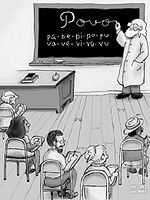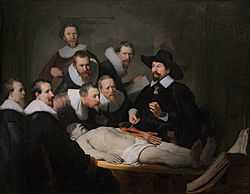Lecture 2.0
Lecture 2.0 refers to a learning and research project to explore use of Web 2.0 principles, philosophy, and technologies in enhancing the pedagogical value of "traditional" style lectures (Lecture 1.0). Note that the numbers (1, 2, 3 etc.) don't really matter much - they are just a way to signify some possible evolutions or mutations of the traditional lecture. |
|
Got a view? Fantastic. Can you improve this resource? Even better. Be bold and hit "edit" :) (or post to the talk page). |
Statement of the problem
Something is rotten in the state of the lecture! Whilst it's one of the oldest forms of communication and teaching, student numbers in lectures appear to be dwindling. This claim seems to be at least anecdotally true in Australian universities in the 2000s compared to previous decades, and the issue is increasingly being recognised (references needed; cf Tahir, 2008). From this observation stem several possible points of departure, not the least of which are:
- "Why?" and
- "What (if anything) should be done about it?".
This learning resource aims to describe explore these and related issues and to explore "new" ways for the lecture in the 21st century.
Description of lecture practices
Lectures are far from monolithic. A "lecture" can and does mean many things. So, in order to have a meaningful discussion, we need some sort of descriptive taxonomy. This (incomplete) section aims to roughly typologise lecture forms. Please add your own conceptions - e.g., describe how you lecture or what do you like or not like about lectures. What are lectures good for and what alternative or enhancing pedagogical methods might be used?
Lecture 1.0


The Lecture 1.0 (traditional lecture) style often exhibits at least several of these distinguishing or defining characteristics:
- One-off, time-bound events; they are generally unique, live performances (although the speaker may replicate the lecture on different occasions and in different locations).
- Copyright of the content is commonly (but doesn't have to be) restricted.
- There is generally limited availability of recordings of the lecture material (text/images, audio, and/or video), lecture slides (e.g., electronic slides with notes). Thus, lecture is generally not easily replayed, copied, reused, etc. although the performance may be repeated live in various locations and times. This emphasis on live performance for Lecture 1.0 risks a rather lecturer-centric (as opposed to student-centric) approach. We might wonder, for example, what happens to the knowledge when the lecturer stops lecturing - hence Lecture 1.0 is rather mortal and fragile. At least a playwright generally leaves behind a script. Many times lecturers leave a university with all their materials - and a new lecturer starts from scratch.
- The style/format is generally "flat" - i.e., "speaking" by an lecturer to a "listening" audience. In communication, this is referred to as a "transmission" model. Is a lecture simply a speech?
- As Stephen Downes points out, the preparation and delivery of a lecture is often a learning experience for the presenter, but not necessarily for those listening to the lecture.
- An engaging presenter may be able to "reach into the audience", take their pulse, and respond accordingly, and thus enhancing engagement and involvement - e.g., some speakers who are particularly good at this are paid large sums and/or attract large crowds just to hear them speak in Lecture 1.0 style. However, these individuals tend very much to be exceptions, with a relatively large number of boredom-inducing lectures occurring for every engaging lecture.
- Limited audience participation/involvement (didactic), although we see some inklings of Lecture 1.5 e.g., with "questions from the floor".
- May or may not use visual images (e.g., projected text /images) to accompany spoken text.
- Because Lecture 1.0 is so lecturer-centric, much is dependent on lecturer expertise with the content, and with lecture style. In "banking education" (see Freire), we find a surprising lack of these two qualities (content and style expertise), and this is much in evidence in 21st century tertiary-education. Often experts are more likely to become researchers or to move into consulting/industry, leaving their younger, less experienced, and less knowledgable counterparts to "deliver" content to the masses.
- Textbook publishers work hard to make their own lecture slides and images for commercial textbooks readily available to lectures - to help make lecturing on a new topic "easy".
Chalk-and-talk
|
 A caricature illustrating a "Chalk and talk" style lecture. |
Lecture 1.5

Lecture 1.5 might be used to describe the steps involved in journeying from Lecture 1.0 to Lecture 2.0. Such steps might include:
- Lecture recordings (audio, video, electronic files).
- Open licensing, open formats, and open access.
- Interactivity between lecturer and audience.
- Chunking of lecture content into digestable pieces.
From a practical point of view, this is what most institutions could be doing right now and are starting to:
- Audio and video stream and record all lectures.
- Release the lecture text/slide materials, audio, and videos (hopefully using open licensing).
- Chunking lecture content so that it can be used in a greater variety of ways.
- Rationalising what belongs best in lecture style and for other content, shaping into other media.
- Make greater use of free and open educational media resources (e.g., video clips) of real experts on topics (which gives students freedom to use/remix/copy, etc.).
For such approaches:
- Should be 'easy'. However not all academic lectures make good "TV" the Open University has over the years moved on from its (sometimes derided) twilight lecture format to the use of celebrities to help deliver their message; which is often part of a larger whole. The more focused website ted.com where lecturers deliver online whilst at the same time to a receptive live audience shows that only a combination of the best speakers on the hottest topics with often good/great graphics succeed in appealing to distant audiences.
- Requires cultural r/evolution especially around intellectual property - but MIT etc. started, catalysing others to follow.
- Is simply good pedagogical practice, but needs more training, action, commitment, examples, etc.
- As per 3.
- Let's do it - education and promotion of available resources needed e.g. see Educational Media Awareness Campaign.
Example 1: Hardt 2005For a rather unique combination of slideshow and lecturer style, see what you think of Dick Hardt's Identity 2.0 - maybe not everyone's cup of tea, but generally people who watch this seem to be "wowed" into thinking new ideas about how we might do lectures differently. Example 2: Neill 2008At the moment, here's how James Neill provides lectures - live, audio and video recorded with accompanying electronic materials, including open-licensed slide presentation (using http://slideshare.net) with downloadable .odp format files (open document presentation, created using Open Office Impress, a free and open source slide presentation software)), pdf handout downloads via a university enterprise wiki (note: I've recently discovered that pdf files can be uploaded to Wikimedia Foundation wiki projects so will try this in future), plus accompany wikitext pages containing notes, activities, links, etc. Audio and video are currently only available to enrolled students and in Windows formats (.wma and .wmv). Some goals to progress towards are:
Example 3: Lecture as Performance
Example 4: My last lecture
Example 5: Lecturer as DJImagine a teacher as a DJ, keeping a class kicking like a dance floor - alive and inspired. David Wiley did back in December of 2005. Since then Brian Lamb has mixed media in real life and second life lectures, and here he points to Gardner Campbell mixing it up. Michael Wesch does it in a more low key but even more potent way. The lecture is not dead - far from it. It is enhanced by the media age - so long as it samples and remixes media - even makes it central to the experience. Teaching has always had a lot in common with performance. As First Monday contributor Doug Brent wrote in April 2005, Teaching as Performance in the Electronic Classroom. |
Lecture 2.0

A significant proportion of tertiary-level teaching lectures tend to have become more or less didactic and repeated relatively unchanged year after year. (This differs, say, from conference presentations which tend to be relatively unique.)
Thus, some institutions are experimenting with recording lectures one year, and then providing students with the recordings the following years and then putting the face-to-face teaching time instead into more interactive learning activities and learning support for students.
If effort is put into a creating a high quality recording, then we are making a kind of educational "documentary". A high quality documentary offers potentially higher pedagogical value than a series of ill-prepared lecture by a lecturer who is not necessarily particularly expert in the subject at hand (as is often the case in modern universities).
Some other possibilities for Lecture 2.0 strategies might include:
- Lecture streaming and recording, e.g.,
- iTunes U
- Smaller, chunk-style lectures on specific topics
- Greater interactivity / experientialness
- Encouragement of collaboration among 'students' using other web 2.0 resources
One example of Lecture 2.0 being carried put into practice is what the Los Altos primary (elementary) school in California have done integrating Khan Academy content into their curriculum to provide greater teacher student time.
Pedagogical possibilities
Alternatives to the lecture
|
Principles/ideas
|
See also
- Favourite presentations
- Lecture
- Help:Lecture
- To do (notes to be actioned)
External links
- Are you reaching those at the back?, Tariq Tahir, 10 January 2008, Times Higher Education
- Editorial: For the sake of argument—If the Conventional Lecture is Dead, Why Is It Alive and Thriving? (Don Woods, 2006)
- Is the lecture dead? (On the evolution of Lecture 2.0) (2007, James Neill, ucspace)
- My last lecture (Tom Worthington from the Australian National University explains why he's given up lecturing in favour of blended learning, 20 August, 2008).
- When computers leave classrooms, so does boredom, July 20, 2009, The Chronicle of Higher Education
- Possible debate: The lecture is dead - Are you interested? (TALO discussion thread, 2008)
- Reinventing teaching and learning, 2008, Parker Rossman
- Students say no to podcasts, Bernard Lane, September 10, 2008, The Australian.
- The Impact of Web-Based Lecture Technologies on Current and Future Practices in Learning and Teaching (Gosper et al., August, 2008; pdf) - See also Overview - Summary of key findings from the Executive Summary
- The future of the lecture (TALO discussion thread, 2006)
- The future of the lecture, 8/3/2006, Michael Nelson (blog post)
- The lecture is dead, September 10, 2008, Tom Worthington
- The Lecture is dead?, February 17th, 2006, Matt Lingard - also see College of Law scraps LPC lectures for online tutorials
- "The Lecture is Dead. Long Live the Lecture.", September 24, 2007, Steve Gilbert
- You only get this type of education in class - Mythic attributes of the lecture, Stephen Downes, June 9, 2009
- R.M. Felder and R. Brent, "Death by PowerPoint," Chem. Engr. Education, 39(1), 28-29 (2005).
- Stand and deliver on its last legs, Jim Barber, 23/10/2010, The Australian